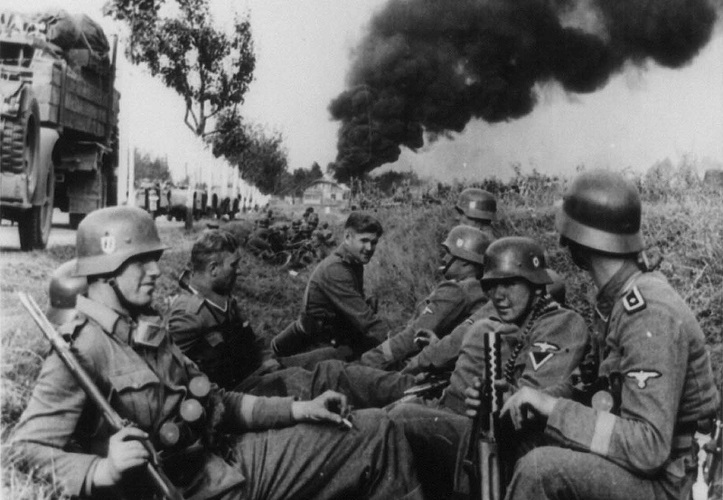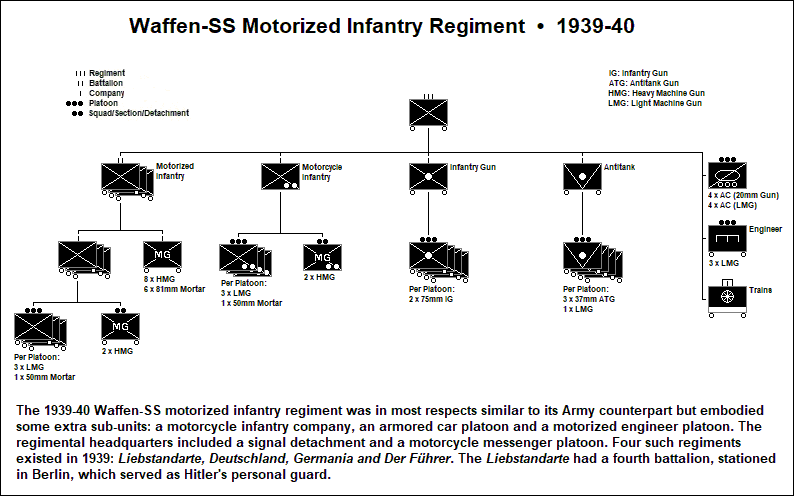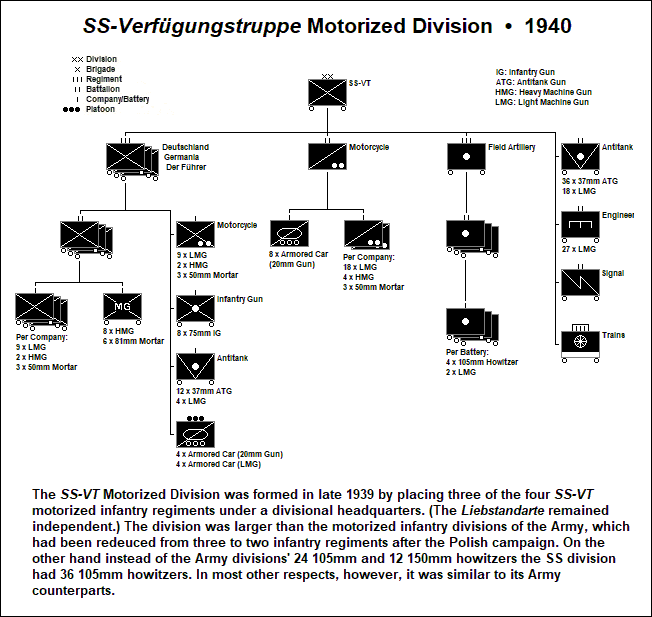|
● ● ●
Though the armed military branch of the
Schutzstaffel—the Waffen-SS—was separate from the
Army it served under Army operational control throughout the war. It
got its start in 1933 when Sepp Detrich, Hitler’s former chauffeur
and bodyguard who’d been made an SS officer, organized a small unit
of about 200 men to serve as the Führer's personal guard. It soon
grew to the size of a regiment and in 1934 was titled the
Liebstandarte Adolf Hitler,
later amended to Liebstandarte SS-Adolf Hitler.
Standarte may be
translated as regiment and Liebstandarte
as bodyguard
regiment.
Himmler's intention was to build up
an SS armed force, completely loyal to the National Socialist regime,
that would
rival and eventually
replace the Army. To that end,
personnel
were carefully selected, underwent rigorous physical and military
training, and were thoroughly indoctrinated in Nazi racial ideology.
The
men of the armed SS were obliged to swear a personal oath of loyalty
to Hitler, pledging "obedience unto death." In 1937 an officer
training school was opened: the
SS-Junkerschule
Bad Tölz. In line with Himmler's long-range plans, the school's
curriculum aimed at the production of politically and ideologically
conscious officers, free of the conservative prejudices and outmoded
habits of thought that Himmler believed to be characteristic of the
Army officer corps. A second
SS-Junkerschule
was later established in the city of
Braunschweig.
The armed SS
had its own unit designations and rank titles, similar to those of
the SA (Stormtroopers), e.g.
Standarte
for regiment
and Standartenführer
for colonel; its black prewar uniform and field gray wartime uniform were
similarly distinctive.
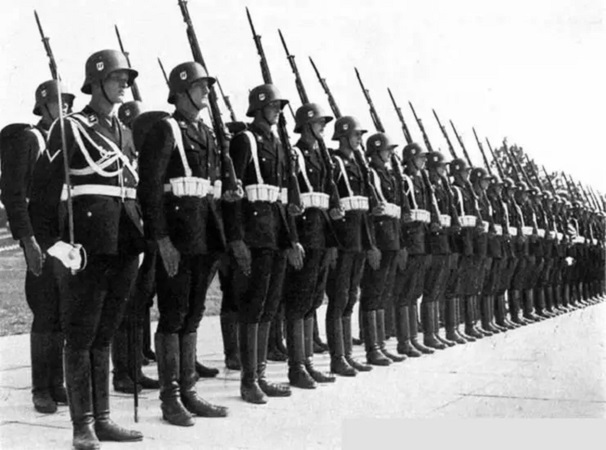
Men of the Liebstandarte, circa 1938; the
black uniform and white leather equipment were seldom worn after the
war's outbreak (Photo: Bundesarchiv)
Between 1934 and 1939 Himmler clashed
repeatedly with the Army leadership over the expansion of the
SS-Verfügungstruppe
(SS Special Service Troops) as
the armed SS came to be called. Though the
Liebstandarte
remained independent under Sepp Detrich's command, the rest of the
SS-VT
was commanded by
Grüppenfuhrer
(lieutenant-general)
Paul Hausser.
He was a former Army general officer who had joined the Nazi Party
after retiring, and it was mainly due to him that it became an
effective fighting force.
But the Army High Command, which
controlled military manpower and resources, gave the
SS-VT
low priority so that by 1939 only four regiments (Liebstandarte
SS-Adolf Hitler,
Deutschland, Germania, Der Führer), a field artillery
regiment, a motorized reconnaissance battalion and some smaller
units had been raised. Together these were sufficient to
form a motorized infantry division but since no divisional
headquarters had been organized as yet, the
SS-VT
units were dispersed throughout the Army at the beginning of the
war. Deutschland,
for example, was assigned to
Panzerverband Kempf,
a provisional headquarters formed to command various armored and
motorized units stationed in East Prussia.
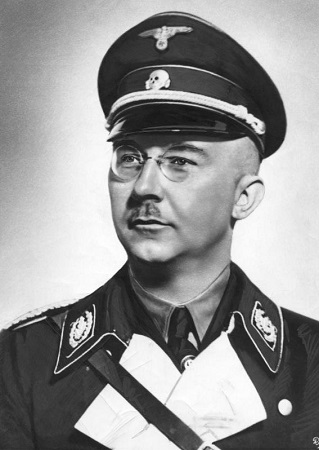
Heinrich Himmler,
Reichführer-SS,
who saw his armed SS as a key component of the future Reich (Photo:
Imperial War Museum)
Organizationally, the four
SS-VT
regiments were similar to an Army motorized rifle regiment but had
extra units such as a motorcycle infantry company and an armored car
platoon.Three of them—the
Liebstandarte,
Germania
and
Deutschland—participated
in the Polish campaign and there they committed the first of many
atrocities for which the Waffen-SS
was to become notorious. The
Liebstandarte,
for example, is known to have murdered some 250 Polish civilians,
including Jews, mowing them down with machine guns.
In
October 1939 three of the four
SS-VT
regiments and various other units were finally brought together
under a division headquarters to form the
SS-VT
Motorized Division. It was similar to but larger than the Army’s
motorized infantry divisions, which were reduced from three regiments
to two after the Polish campaign. Also raised at this time
was the SS-Totenkopf Motorized Division. This unit drew most
of its men from the SS-Totenkopfverbände (SS Death’s Head
Units), the SS branch charged with guarding and administering
concentration camps. It was organized similarly to the SS-VT
Motorized Division and was armed in part with captured Czech
weapons. The
Liebstandarte
remained independent and was soon expanded to the size of a brigade.
A fourth division raised at this time under Himmer’s auspices was
the Polizei Division. Its men came from the Ordnungspolizei (Order Police), which Himmler commanded in his
capacity as Chief of German Police. It was organized as an infantry
division, with various support units supplied by the Army. When
formed the Polizei Division was not classified as an SS
formation, though it was later merged into the Waffen-SS.
For the 1940 campaign it was assigned to Army Group C opposite the
Maginot Line, and saw action toward the end of the battle.
The
Liebstandarte, SS-VT
and SS-Totenkopf
all participated in the 1940 campaign, and once again the armed SS
displayed its propensity for atrocities. In the village of Le
Paradis, Totenkopf
troops massacred 97 British troops after they surrendered and
Liebstandarte troops shot
some 80 surrendered French and British soldiers near Dunkirk.
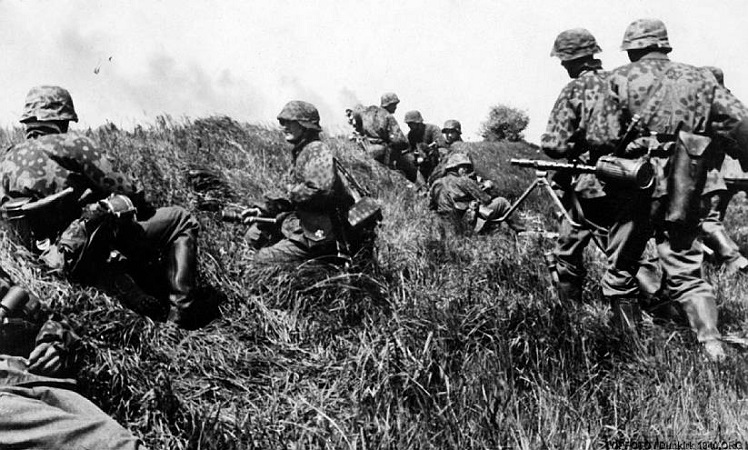
SS-VT infantry in France,
June 1940; the camouflaged smock and helmet cover were distinctive
items of uniform. (Photo: Bundesarchiv)
In July 1940, a Führer decree
officially renamed the SS-VT;
henceforward it would be known as the Waffen-SS
and would have its own higher command for administrative purposes.
In December 1940 another Waffen-SS
motorized division was formed. One of its regiments was Germania, transferred from the
SS-VT Division. Other
recruits were volunteers from the so-called Nordic countries under
German occupation: Norwegians, Danes, Dutch, Flemings. Originally
this division was titled Germania;
later it was renamed Wiking
(Viking).
The SS divisions
were organizationally similar to their Army counterparts but
generally larger, and Himmler exerted his considerable influence to ensure that
they received the latest weapons and equipment. They soon gained a
reputation as elite combat units, but this was due in large part to the
fact that they were bigger and better equipped than corresponding
Army divisions. Later in the war it was estimated that the resources
required for two Waffen-SS
panzer divisions could have been used to form three Army panzer
divisions instead. The creation and expansion of the Waffen-SS was thus a mistake,
consuming resources that could have been used more efficiently to
bolster the strength of the Army.
Nevertheless, by the end of 1940
the units that would later become the five senior Waffen-SS
divisions were in existence, with a major expansion of the
Waffen-SS
in the offing.
● ● ●
|
